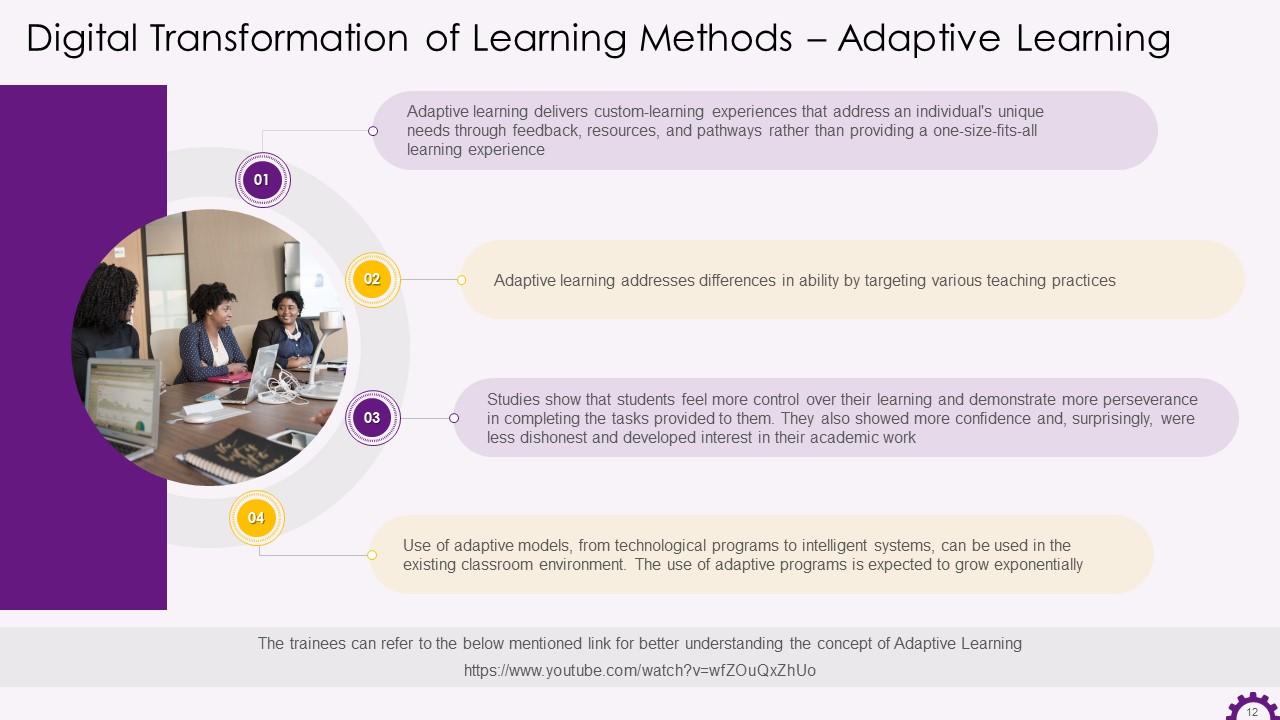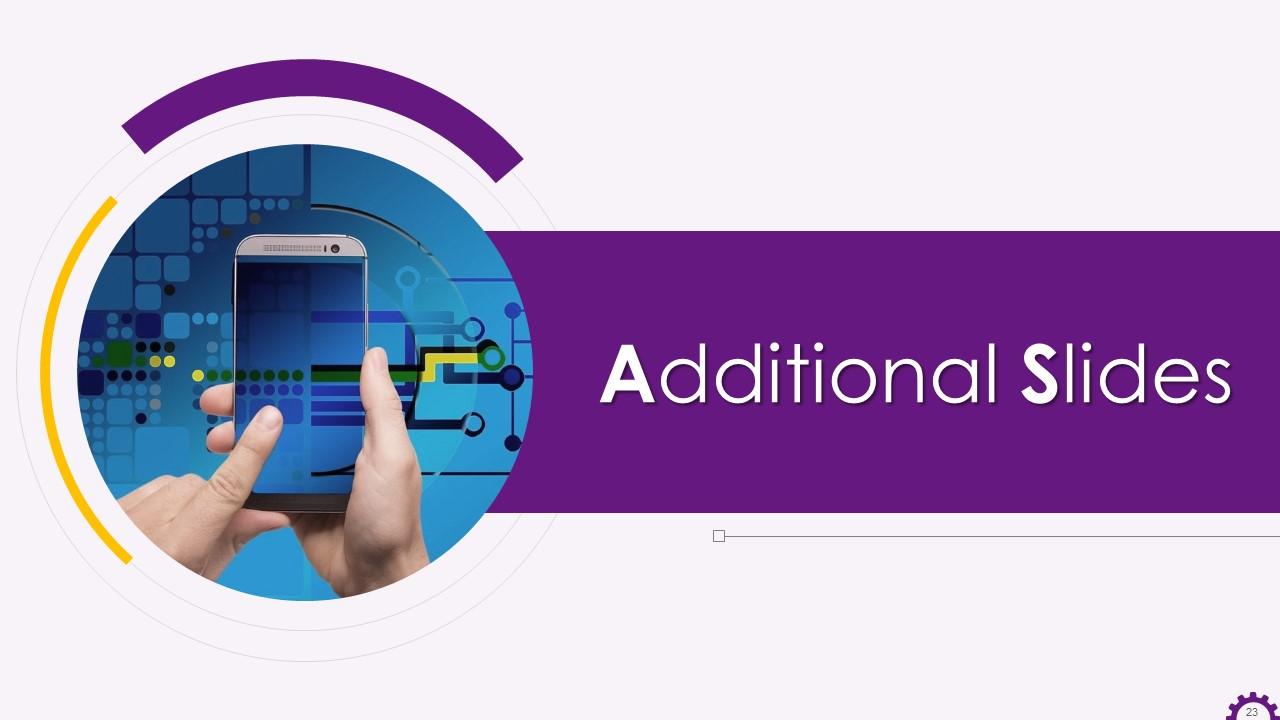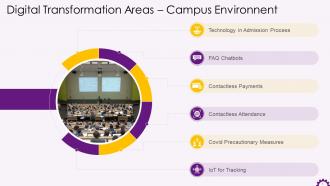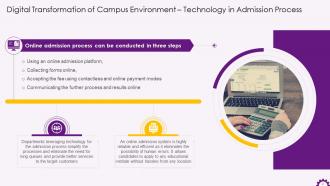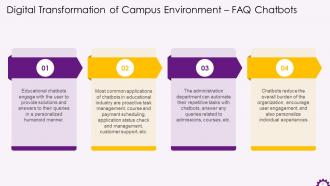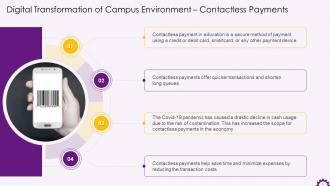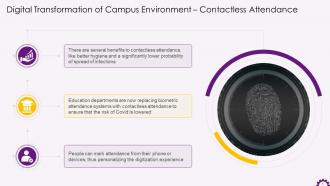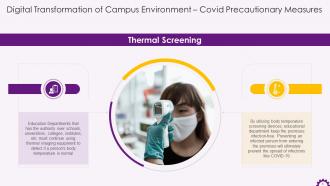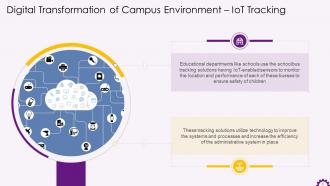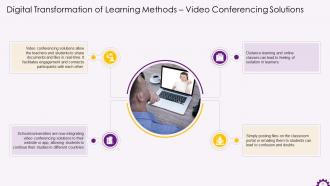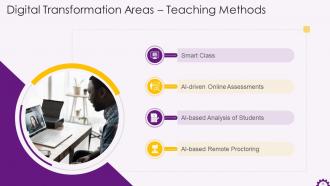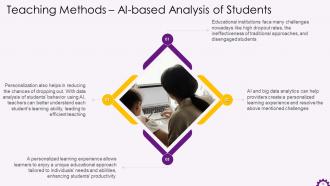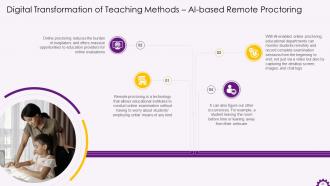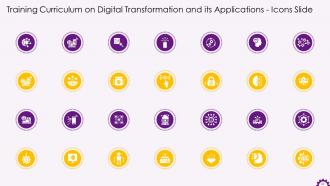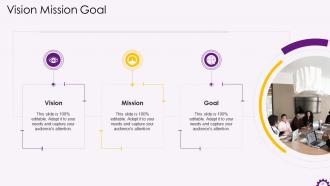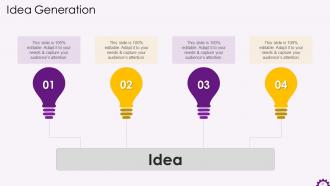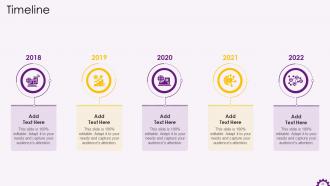Education Learning Methods And Campus Environment Digital Transformation Training Ppt
This set of slides, in-depth, covers technologies to accomplish educational institutes campus digitalization with contactless payments and attendance, using FAQ chatbots and IoT for tracking. It also showcases the utility of AR or VR Augmented Reality or Virtual Reality, video conferencing, adaptive learning, learning apps or platforms, AI Artificial Intelligence chatbots, and digital libraries to digitalization learning methods. Further, it covers teaching methods digitalization in the education sector with smart classes, AI Artificial Intelligence based online assessments, students analysis, and remote proctoring.
You must be logged in to download this presentation.
 Impress your
Impress your audience
Editable
of Time
PowerPoint presentation slides
Presenting Education Learning Methods and Campus Environment Digital Transformation. These slides are well crafted and designed by our PowerPoint specialists. This PPT presentation is thoroughly researched by the experts, and every slide consists of appropriate content. You can add or delete the content as per your need.
People who downloaded this PowerPoint presentation also viewed the following :
Content of this Powerpoint Presentation
Slide 1
This slide mentions significance of digital transformation in campus environment. It includes technological advancements in admission process, contactless payments, contactless attendance, covid precautionary measures: Thermal screening and social distancing alert system, FAQ chatbots, and IoT for tracking.
Slide 2
This slide mentions how technology is utilized in the admission process of educational institutions. Online admission process is conducted using online platform, online forms, online payments, and conveying information online.
Slide 3
This slide illustrates the use of FAQ chatbots in educational sector. Educational Chatbots engage with the user to provide solutions and answers to their queries in a personalized humanoid manner. Most common applications of chatbots in educational industry are proactive task management, course and payment scheduling, application status check and management, customer support, etc.
Slide 4
This slide mentions the significance of contactless payments in digital transformation of education. Contactless payment in education is a secure method of payment using a credit or debit card, smartcard, or any other payment device.
Slide 5
This slide explains how educational departments are using contactless attendance systems in educational departments. Educational departments are now replacing biometric attendance systems with contactless attendance to avoid spreading the infection.
Slide 6
This slide explains how educational institutes are implementing thermal screening as a covid precautionary measure in departments. They use thermal imaging equipment to detect if a person's body temperature is normal. Utilizing body temperature screening devices, educational departments keep the premises infection-free. Preventing the contagious person from entering the premises will ultimately prevent the spread of infections like COVID-19.
Slide 7
This slide explains how educational institutes are implementing social distancing alert systems such as a covid precautionary measure in departments. Social distancing alert systems have now been launched that use AI and Computer Vision to detect the distance between two or more people and then send a notification to them or the authorities concerned to take action against them.
Slide 8
This slide explains how IoT tracking is used in management of educational institutions. Educational departments like schools use the school bus tracking solutions having IoT-enabled sensors to monitor the location and performance of busses to ensure children's safety.
Slide 9
This slide mentions the concepts covered under digital transformation of learning methods. The concepts are AR/VR in education, video conferencing solutions, adaptive learning, learning apps/platforms, AI-based chatbots, and digital libraries.
Slide 10
This slide explains how AR/VR is used in education and how it is benefiting the education industry. Augmented Reality/Virtual Reality can help learners grasp abstract concepts and gain hands-on experience on things otherwise impossible in physical world. These technologies aims to promote student engagement and nurture better understanding. Complex concepts can be explained to the students in a controlled environment by making learning immersive and experiential through the Virtual Reality headsets.
Instructor’s Notes:
The most significant benefits of AR/VR in education are:
- AR/VR makes learning experiential and immersive
- It causes enhanced memory retention among learners
- It is considered to be a great aid to students who experience difficulty in learning
- It simplifies complex topics and concepts for better understanding of students
- It fosters self-sufficiency and self-learning among students
- It is a great training tool to instill confidence in learners
- It makes remote learning more engaging and interesting
Slide 11
This slide explains how video conferencing solutions encourage education delivery to people from different countries. Schools/universities are now integrating video conferencing solutions to their website or app, allowing students to continue their studies in different countries. Video conferencing solutions allow the teachers and students to share documents and files in real-time. It facilitates engagement and connects participants with each other.
Slide 12
This slide explains how adaptive learning has improved the students’ learning experience. Adaptive learning delivers custom learning experiences that address an individual's unique needs through feedback, resources, and pathways rather than providing a one-size-fits-all learning experience. Students feel more control over their learning and demonstrate more persistence and patience in program tasks with adaptive learning.
Instructor’s Notes:
Benefits of Adaptive Learning-
- Students can choose the speed of learning or the pace at which they worked
- They were motivated to complete their work This (the increased drive) was visible after just a glance at the progress charts
- They enjoy the teacher's support and explanations during practice sessions
- Students reported more learning and comfort when the content was taught using adaptive learning
- They claimed they were less stressed due to the adaptive pace, as they found themselves ready to move to new concepts
- They experience tremendous success due to their dedication to the learning content. Students' skills saw rapid improvement as they could control the pace and level of difficulty
Slide 13
This slide explains how the educational sector is moving towards online learning platforms for a better experience. Online learning platforms will help students continue their studies without any interruption. It will also allow them to access the best learning content in text format, PDFs, images, and audios.
Slide 14
This slide explains how the AI and Chatbots are encouraging digital transformation in education. The chatbots which are AI-enabled can be used to analyze students’ responses and offer them the content that matches their learning choice. These chatbots can be used to teach students by converting a lecture into a series of messages to give it the feel of a conversation.
Slide 15
This slide explains the benefits of digital libraries in today’s education system. A Digital library cuts the time and effort a person puts into visiting a conventional library and finding the right book. Options like in-built content search using few keywords or titles make searching for what you need from thousands of resources easy and convenient.
Slide 16
This slide mentions the concepts covered under digital transformation of teaching methods. The concepts are adoption of smart classes, AI-driven online assessments, AI-based analysis of students, and AI-based remote proctoring.
Slide 17
This slide explains how the education is transforming from traditional classrooms to smart classrooms. Using smart class technology and interactive whiteboards, the educational departments can illustrate information to students with the help of photos, maps, graphs, flowcharts, and animated videos. This makes learning more attractive, exciting, and easy to understand.
Slide 18
This slide mentions the existence and success of AI-driven online assessments. AI-based online assessment system enables conducting different types of examinations, whether subjective or objective, typing tests, coding simulators or video or audio input. It facilitates a quick and clear report on candidates' progress, making it easier for the education provider to give feedback to the learners on how they have been doing, their strengths, and areas of learning that need improvement.
Slide 19
This slide illustrates digital transformation in analysis of students by utilizing the AI-based analysis system. In education, AI and big data analytics can help providers create a personalized learning experience and resolve challenges like high dropout rates, disengagement of students, etc. An AI-based personalized learning experience allows the learner to enjoy a unique educational approach tailored to individuals’ needs and abilities leading to improved productivity of students.
Slide 20
This slide mentions the technology behind online monitoring of students. Remote proctoring is a technology that allows educational institutes to conduct online examination that prevents students from indulging in any unfair means or practice. Online proctoring reduces burden of invigilators and offers massive opportunities to education providers for online evaluations. With AI-enabled online proctoring, educational departments can monitor the students remotely and record complete examination sessions from the beginning to end, not just via a video but also by capturing the desktop screen, images, and chat logs.
Education Learning Methods And Campus Environment Digital Transformation Training Ppt with all 36 slides:
Use our Education Learning Methods And Campus Environment Digital Transformation Training Ppt to effectively help you save your valuable time. They are readymade to fit into any presentation structure.
-
I’m not a design person, so I couldn’t make a presentation to save my life. Thankfully, they have all kinds of templates that I regularly use for my work.
-
Very well designed and informative templates.














